Bob wrote:
I should point-out that I (for one) don't believe that the words 'potential' & 'voltage' are fully interchangeable, as (it seems to me) that YOU seem to think.
I certainly agree that there's 'POTENTIAL-voltage', but it's not actual 'voltage' until it's measured (in units called: 'volts'), and even an extremely high voltage potential can instantly fall-down to being next to non-existent (without a back-up supply of electrons to hold it up [as 'voltage'], [which together with 'current' becomes 'wattage']).
Mike, I'm just saying that 'potential-voltage' and 'voltage' are not the very-same thing, (quite two different aspects actually !). _ As 'voltage' by itself is truely a one-dimensional entity (thus non-existent) all on it's own !
__ Now do you disagree with this too Mike ? _ (If so, please think carefully before you do, and keep in mind that even a volt-meter passes 'current' to get a volt-reading !)
MM
Voltage, the difference of potential can be created in any number of ways. It could be stated that one point has an abundance of electrons while the other point does not. And yes I admit that a very high voltage can, as soon as a path exists drop down to nothing, But so what, it existed until it didn't. Once those electron count is balanced out, the voltage is does not exist between the two points. When you touch your car when the air is very dry and you get a shock for instance. In fact in that case the voltage is so high that the electrons actually will make the jump across a gap a quarter inch or so to go through you.
I can't tell if I disagree or not because I don't understand you. Your esoteric definitions, even if you can find a reference that supports, them while making you right, serve to complicate the understanding of a circuit. If it was pertinent to figuring out what was going on, or was correcting a blatant misunderstanding of commonly used terminology it would make sense to do try to make these points. Surely voltage existed in your 120vac outlet before you stuck a hairpin in it (make that a 240 outlet)and detected it. Or that no voltage was present in the sky until the lightening? It seems that you generate a semantic issue to obfuscate the simple and drag it out and make it more complex than it needs to be. I wonder why.
n-c alternator modifications: discussion and testing
Moderator: ajleone
-
MotoMike
- Posts: 487
- Joined: Wed Aug 04, 2010 3:40 am
Re: 6volt or 12 volt?
Bob wrote:
__ Why do you feel the need to make the point that you agree with Bill on that ? _ As that's of course so very true, that ANYone should understand it (that it takes a higher voltage to charge that of a lower voltage).
Did I state something else that you did not understand correctly (as I had actually meant) ?
MM.
I said that because in Bill's testing of the parallel independant testing he came up with voltages across a 55watt about load that would only begin to charge the 12 volt battery when spinning he alternator at 6k. He stated as much and you told him it was wrong on several levels. Just stating that I agreed with him.
____ Since you brought this up as well, here's another thing for you to (possibly) disagree with...
I claim that even a power-source with over 100 potential-volts (or even measured volts), won't charge a 12-volt battery (without a store of electrons to supply a 'current') !
MM
100 volts indicates that there is a store of electrons. If they result from some source that will not keep the flow of electrons coming, no it won't charge the battery once it's level drops below battery voltage. the difference of potential is the difference in the number of electrons between two points, but there are so many that it is hard to count them.
_ Cuz 'voltage' alone can-not exist, (outside of your "instant of time" concept), without current (wattage) to back it up. _ Only "potential" -(the 'assumption' of voltage !) exists ! _ (And not 'voltage' alone ! _ As 'voltage' truly does not exist until it's measured as such. _ And thus the reason for the term 'potential' !!)
So, 'potential', (simply measurable in 'voltage'), IS (more so) "the driver and where it begins".
MM
Bob, I wish you would speak more clearly. the formulas for voltage that most of us are familiar with use ohms law e/r=I and IxR=E. I don't know if that is why you say Voltage can't exist without the others or not. but there are other formulas that are seldom seen because they serve little purpose in understanding what is going on in the circuits. One for you to consider speaks to the excess number of electrons on one point compared to another expressed in coulombs divided by capacitance expressed in farads equals voltage. this is used to express the voltage across plates of a capacitor, but could be used to express the voltage across any two points as they all have capacitance and will commonly have different electron counts on them. I am not saying this is a practical formula for voltage for anything we will do, but it shows this voltage exists while no current is flowing and it is not being measured.
____ (As they say... Put all that in your pipe & smoke it.)
And I don't smoke, especially whacky tabaccy
__ Why do you feel the need to make the point that you agree with Bill on that ? _ As that's of course so very true, that ANYone should understand it (that it takes a higher voltage to charge that of a lower voltage).
Did I state something else that you did not understand correctly (as I had actually meant) ?
MM.
I said that because in Bill's testing of the parallel independant testing he came up with voltages across a 55watt about load that would only begin to charge the 12 volt battery when spinning he alternator at 6k. He stated as much and you told him it was wrong on several levels. Just stating that I agreed with him.
____ Since you brought this up as well, here's another thing for you to (possibly) disagree with...
I claim that even a power-source with over 100 potential-volts (or even measured volts), won't charge a 12-volt battery (without a store of electrons to supply a 'current') !
MM
100 volts indicates that there is a store of electrons. If they result from some source that will not keep the flow of electrons coming, no it won't charge the battery once it's level drops below battery voltage. the difference of potential is the difference in the number of electrons between two points, but there are so many that it is hard to count them.
_ Cuz 'voltage' alone can-not exist, (outside of your "instant of time" concept), without current (wattage) to back it up. _ Only "potential" -(the 'assumption' of voltage !) exists ! _ (And not 'voltage' alone ! _ As 'voltage' truly does not exist until it's measured as such. _ And thus the reason for the term 'potential' !!)
So, 'potential', (simply measurable in 'voltage'), IS (more so) "the driver and where it begins".
MM
Bob, I wish you would speak more clearly. the formulas for voltage that most of us are familiar with use ohms law e/r=I and IxR=E. I don't know if that is why you say Voltage can't exist without the others or not. but there are other formulas that are seldom seen because they serve little purpose in understanding what is going on in the circuits. One for you to consider speaks to the excess number of electrons on one point compared to another expressed in coulombs divided by capacitance expressed in farads equals voltage. this is used to express the voltage across plates of a capacitor, but could be used to express the voltage across any two points as they all have capacitance and will commonly have different electron counts on them. I am not saying this is a practical formula for voltage for anything we will do, but it shows this voltage exists while no current is flowing and it is not being measured.
____ (As they say... Put all that in your pipe & smoke it.)
And I don't smoke, especially whacky tabaccy
-
DewCatTea-Bob
- Posts: 2897
- Joined: Sun Nov 01, 2009 10:53 am
- Location: Near SE side of Lake Michigan
Re: 6volt or 12 volt?
" I can't tell if I disagree or not because I don't understand you. Your esoteric definitions, even if you can find a reference that supports, them while making you right, serve to complicate the understanding of a circuit. If it was pertinent to figuring out what was going on, or was correcting a blatant misunderstanding of commonly used terminology it would make sense to do try to make these points. Surely voltage existed in your 120vac outlet before you stuck a hairpin in it (make that a 240 outlet)and detected it. Or that no voltage was present in the sky until the lightening? It seems that you generate a semantic issue to obfuscate the simple and drag it out and make it more complex than it needs to be. I wonder why. "
____ Well Mike, the reason why is it just goes to show that what SEEMS to be correct or incorrect, depends on one's understanding of what's really what. ...
I'll just say the following... I'm sure if you ask most any common electrical-technician if voltage exists in a power-source, HE would then simply say "yes". _ But, if you were to ask a top-Professor of physics "Does 'voltage' exist ?" , I believe he would then ask "Do you mean 'measured voltage' or 'POTENTIAL voltage' ?"
You see, 'voltage' exists much in the same way that water-pressure can exist... take away the water (which is more equivalent to wattage), and there's then no pressure. _ So just as water-pressure can't exist without water, 'voltage' can't exist without potential-power. _ And that power can't take shape as either high-voltage & low-current, or, low-voltage & high-current, UNTIL a connected circuit dictates whichever the particular condition ! _ So until such occurs, there is no 'voltage' , only the 'potential' for a voltage ! _ As the voltage 'amount' does-not exist until there's a circuit to create it !
Mike, 'voltage' is a measurement of potential, is it not ? _ And I (for one) believe any other use of the term, is misleading 'slang' !
__ In the case of the 120v-outlet, that is a purposely designed voltage-output setting, with relatively unlimited power to keep the set voltage maintained,, thus not a fair comparison to alternators which don't have a 'set' power-output.
That's All,
-Bob
____ Well Mike, the reason why is it just goes to show that what SEEMS to be correct or incorrect, depends on one's understanding of what's really what. ...
I'll just say the following... I'm sure if you ask most any common electrical-technician if voltage exists in a power-source, HE would then simply say "yes". _ But, if you were to ask a top-Professor of physics "Does 'voltage' exist ?" , I believe he would then ask "Do you mean 'measured voltage' or 'POTENTIAL voltage' ?"
You see, 'voltage' exists much in the same way that water-pressure can exist... take away the water (which is more equivalent to wattage), and there's then no pressure. _ So just as water-pressure can't exist without water, 'voltage' can't exist without potential-power. _ And that power can't take shape as either high-voltage & low-current, or, low-voltage & high-current, UNTIL a connected circuit dictates whichever the particular condition ! _ So until such occurs, there is no 'voltage' , only the 'potential' for a voltage ! _ As the voltage 'amount' does-not exist until there's a circuit to create it !
Mike, 'voltage' is a measurement of potential, is it not ? _ And I (for one) believe any other use of the term, is misleading 'slang' !
__ In the case of the 120v-outlet, that is a purposely designed voltage-output setting, with relatively unlimited power to keep the set voltage maintained,, thus not a fair comparison to alternators which don't have a 'set' power-output.
That's All,
-Bob
PLEASE NOTE... If this-post is not-yet signed-off with '-Bob', then I'm still in the process of completing it,, and if not also included with 'DCT' near bottom as well, then I may edit this post's wording at a later time. - Dct.Bob
-
DewCatTea-Bob
- Posts: 2897
- Joined: Sun Nov 01, 2009 10:53 am
- Location: Near SE side of Lake Michigan
Can 'Voltage' exist on it's Own ?
By: MotoMike...
" I said that because in Bill's testing of the parallel independant testing he came up with voltages across a 55watt about load that would only begin to charge the 12 volt battery when spinning he alternator at 6k. He stated as much and you told him it was wrong on several levels. "
____ Sorry Mike, but that must be a condensation of things you recently read (within this thread), cuz such as that has not occurred !
" Bob, I wish you would speak more clearly. the formulas for voltage that most of us are familiar with use ohms law e/r=I and IxR=E. I don't know if that is why you say Voltage can't exist without the others or not. but there are other formulas that are seldom seen because they serve little purpose in understanding what is going on in the circuits.
One for you to consider speaks to the excess number of electrons on one point compared to another expressed in coulombs divided by capacitance expressed in farads equals voltage. this is used to express the voltage across plates of a capacitor, but could be used to express the voltage across any two points as they all have capacitance and will commonly have different electron counts on them. I am not saying this is a practical formula for voltage for anything we will do, but it shows this voltage exists while no current is flowing and it is not being measured. "
____ A fairly good example/point for your view-point Mike ! _ However here-again the calculated voltage is no more concrete, since of course it's also naturally dependent on the circumstances which cause simple 'potential' to become a particular set voltage-value/figure, and it's value (which is what voltage really is), fully depends on other factors,, as in this presented case, the distance between the oppositely charged plates as well as their size, etc. _ Thus in this case also, 'voltage' is not a concrete stand-alone real conception without introduction of the factors which mold it (into whatever it becomes),, unlike the number of molecules that the condenser-plates are made from or the number of electrons they hold (which are both indeed concrete amounts), the 'voltage' between the plates is not likewise a set/consistent value-amount (as most people may assume voltage to likely be).
Indeed potential voltage can actually become a wide range of voltage-values (dependent entirely on OTHER factors !).
____ So getting back to the alternator,, it doesn't provide any voltage-values or current-rates of it's own, because it only has 'wattage' to offer, and it's the CIRCUITS (of electrical components) which it's connected to, that make the wattage into set amounts of current & voltage !
And this is why I say it's better to think in 'wattage' rather than just voltage or amperage.
" And I don't smoke, especially whacky tabaccy "
____ I myself have never smoked anything. _ But I didn't mean to suggest anything of the kind Mike ! ... As "Put-that-in-your-pipe-and-smoke-it-! ", is an old-saying similarly meaning to "absorb this & digest it".
Dukddy-Dukes,
-Bob
" I said that because in Bill's testing of the parallel independant testing he came up with voltages across a 55watt about load that would only begin to charge the 12 volt battery when spinning he alternator at 6k. He stated as much and you told him it was wrong on several levels. "
____ Sorry Mike, but that must be a condensation of things you recently read (within this thread), cuz such as that has not occurred !
" Bob, I wish you would speak more clearly. the formulas for voltage that most of us are familiar with use ohms law e/r=I and IxR=E. I don't know if that is why you say Voltage can't exist without the others or not. but there are other formulas that are seldom seen because they serve little purpose in understanding what is going on in the circuits.
One for you to consider speaks to the excess number of electrons on one point compared to another expressed in coulombs divided by capacitance expressed in farads equals voltage. this is used to express the voltage across plates of a capacitor, but could be used to express the voltage across any two points as they all have capacitance and will commonly have different electron counts on them. I am not saying this is a practical formula for voltage for anything we will do, but it shows this voltage exists while no current is flowing and it is not being measured. "
____ A fairly good example/point for your view-point Mike ! _ However here-again the calculated voltage is no more concrete, since of course it's also naturally dependent on the circumstances which cause simple 'potential' to become a particular set voltage-value/figure, and it's value (which is what voltage really is), fully depends on other factors,, as in this presented case, the distance between the oppositely charged plates as well as their size, etc. _ Thus in this case also, 'voltage' is not a concrete stand-alone real conception without introduction of the factors which mold it (into whatever it becomes),, unlike the number of molecules that the condenser-plates are made from or the number of electrons they hold (which are both indeed concrete amounts), the 'voltage' between the plates is not likewise a set/consistent value-amount (as most people may assume voltage to likely be).
Indeed potential voltage can actually become a wide range of voltage-values (dependent entirely on OTHER factors !).
____ So getting back to the alternator,, it doesn't provide any voltage-values or current-rates of it's own, because it only has 'wattage' to offer, and it's the CIRCUITS (of electrical components) which it's connected to, that make the wattage into set amounts of current & voltage !
And this is why I say it's better to think in 'wattage' rather than just voltage or amperage.
" And I don't smoke, especially whacky tabaccy "
____ I myself have never smoked anything. _ But I didn't mean to suggest anything of the kind Mike ! ... As "Put-that-in-your-pipe-and-smoke-it-! ", is an old-saying similarly meaning to "absorb this & digest it".
Dukddy-Dukes,
-Bob
PLEASE NOTE... If this-post is not-yet signed-off with '-Bob', then I'm still in the process of completing it,, and if not also included with 'DCT' near bottom as well, then I may edit this post's wording at a later time. - Dct.Bob
-
wcorey
- Posts: 323
- Joined: Sun Jan 31, 2010 1:50 am
- Location: MA USA
Re: 6volt or 12 volt?
Sheesh, all this nit-picking about... whatever it is... I'm too tired to try and follow it...
Anywho, back to business.
Not that it's a bad thing but I'm not used to this going back days later and editing of major content into past posts and I can't seem to get a handle on it, sorry if I'm missing questions and such. I just found a bunch of stuff a few pages back and don't know when it appeared but here's the result of it combined with today's requests. It's late, I think I hear birds chirping, means it's past time for bed, hopefully I didn't f' too much of it up...
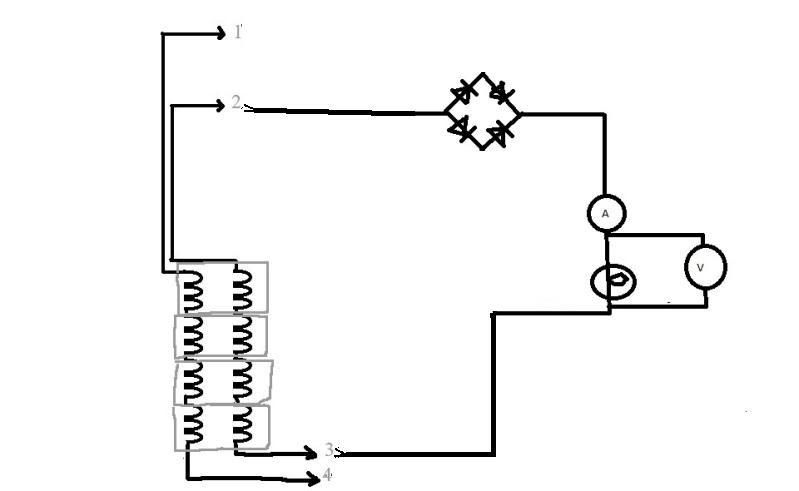
halfwave rectified, 'one side', 3ohm, 3450rpm, 1.8a, 15.5vac, 5.6vdc
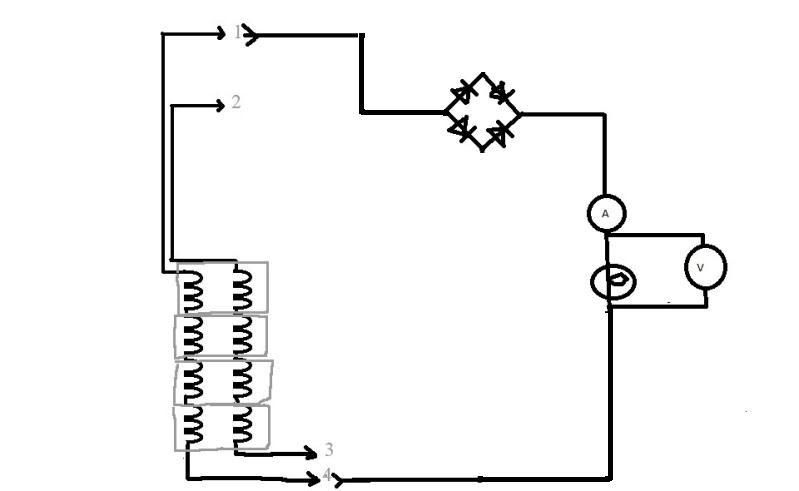
halfwave rectified, 'the other side', 3ohm, 3450rpm, 1.8a, 15.6vac, 5.7vdc
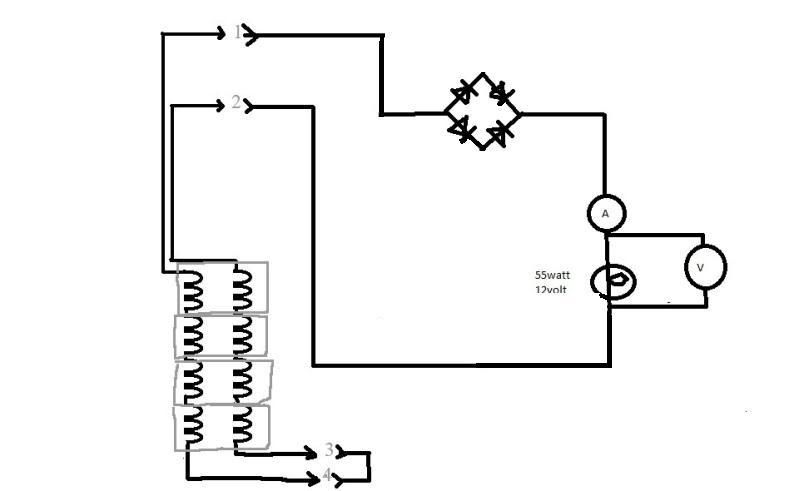
halfwave rectified, series, 3ohm, 3450rpm, 2.6a, 23.9vac, 8.2vdc
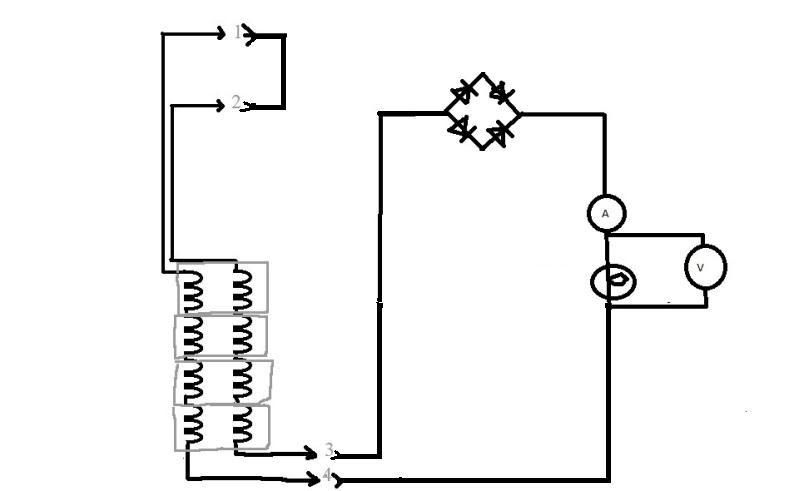
halfwave rectified, series reversed, 3ohm, 3450rpm, 2.6a, 23.9vac, 8.2vdc
Couldn't locate a drawing for this one. These parallel setups are a PITA...
halfwave rectified, parallel, 'one side', 3ohm, 3450rpm, 1.8a, 14.6vac, 8vdc <edit> (Shit! Just realized the vdc readings are a decimal place off in the pics, I must have configured something wrong, should be right around 5.5vdc. I'll deal with it later...) (Later...The red lead on the dc meter is on the dc output of the rec., should be on the red clip on the load)
halfwave rectified, parallel, 'the other side' , 3ohm, 3450rpm, 1.8a, 14.8vac, 7.7vdc
Bill
Anywho, back to business.
Not that it's a bad thing but I'm not used to this going back days later and editing of major content into past posts and I can't seem to get a handle on it, sorry if I'm missing questions and such. I just found a bunch of stuff a few pages back and don't know when it appeared but here's the result of it combined with today's requests. It's late, I think I hear birds chirping, means it's past time for bed, hopefully I didn't f' too much of it up...

halfwave rectified, 'one side', 3ohm, 3450rpm, 1.8a, 15.5vac, 5.6vdc

halfwave rectified, 'the other side', 3ohm, 3450rpm, 1.8a, 15.6vac, 5.7vdc

halfwave rectified, series, 3ohm, 3450rpm, 2.6a, 23.9vac, 8.2vdc

halfwave rectified, series reversed, 3ohm, 3450rpm, 2.6a, 23.9vac, 8.2vdc
Couldn't locate a drawing for this one. These parallel setups are a PITA...
halfwave rectified, parallel, 'one side', 3ohm, 3450rpm, 1.8a, 14.6vac, 8vdc <edit> (Shit! Just realized the vdc readings are a decimal place off in the pics, I must have configured something wrong, should be right around 5.5vdc. I'll deal with it later...) (Later...The red lead on the dc meter is on the dc output of the rec., should be on the red clip on the load)
halfwave rectified, parallel, 'the other side' , 3ohm, 3450rpm, 1.8a, 14.8vac, 7.7vdc
Bill
Last edited by wcorey on Fri Jul 29, 2011 5:45 pm, edited 3 times in total.
-
DewCatTea-Bob
- Posts: 2897
- Joined: Sun Nov 01, 2009 10:53 am
- Location: Near SE side of Lake Michigan
Re: 6volt or 12 volt?
By: wcorey...
" Not that it's a bad thing but I'm not used to this going back days later and editing of major content into past posts and I can't seem to get a handle on it, sorry if I'm missing questions and such. I just found a bunch of stuff a few pages back and don't know when it appeared "
____ I also had some disorienting experience when the thread-pages were were growing over two per day, missing some stuff because I (probably as you) would click for heading to the newest page and then (not at first) realize I had bypassed a page or two which I also hadn't seen before. _ (Usually, ya don't have to bother to memorize the page-number ya were last kept up to !)
" Anywho, back to business.

halfwave rectified, 'one side', 3ohm, 3450rpm, 1.8a, 15.5vac, 5.6vdc "
____ That's nearly 8-volts AC to produce 10-watts DC.

" halfwave rectified, 'the other side', 3ohm, 3450rpm, 1.8a, 15.6vac, 5.7vdc "
____ That's also nearly 8-volts AC to produce (sightly more than) 10-watts DC.

" halfwave rectified, series, 3ohm, 3450rpm, 2.6a, 23.9vac, 8.2vdc "
____ That's 12-volts AC to produce slightly over 21-watts DC...
Funny-thing is that the total of the two alt.windings together is 1-watt higher than the two separated & added !? _ And on top of that, the combined AC-voltage is only 77% that of the two separate AC-outputs' added-total.
Such inconsistent results makes it unclear as to whether the most efficient circuit is the 'series' or the 'parallel', (and it actually ought-not really matter).

" halfwave rectified, series reversed, 3ohm, 3450rpm, 2.6a, 23.9vac, 8.2vdc "
____ That's ALSO 12-volts AC to produce slightly over 21-watts DC...
I'm sorry Bill, instead of posting the correct reversed-series circuit, I posted the same standard series-circuit (but just flipped/up-side-down) !
I now have the actually intended (reversed-circuit diagram correctly reflecting the desired reverse-series test setup) wiring-connection scheme-drawing posted (in this post, below), and surely THIS one is actually OPPOSITE the std.series setup !
" Couldn't locate a drawing for this one. These parallel setups are a PITA...
halfwave rectified, parallel, 'one side', 3ohm, 3450rpm, 1.8a, 14.6vac, 8vdc "
____ Not sure which circuit-test this is of, (sounds like it's Mike's [lol].)
It seems that this circuit (whatever it is), uses 7.3-volts AC to produce 14.4-watts.
" Just realized the vdc readings are a decimal place off in the pics, I must have configured something wrong, I'll deal with it later...) "
____ Is that for everything in you last-post, or just this last test ?
" halfwave rectified, parallel, 'the other side' , 3ohm, 3450rpm, 1.8a, 14.8vac, 7.7vdc "
____ Another circuit I'm not sure of...
It seems that it uses 7.4-volts to produce near 14-watts DC.
____ Thanks for the testing Bill !
Is this post covering more than just the 4 tests I wanted ?
I forgot to mention that they ought to be done with the same 1-ohm load as you used for Bruce's full-wave tests, so that the results can be directly compared.
__ Anyhow, with the results of the 4-tests I wanted done, we can now get to ironing-out what's happening in the alt.windings that keeps them from doubling-power when in the std.series-circuit that most everyone usually modifies to.
Tillater,
-Bob
" Not that it's a bad thing but I'm not used to this going back days later and editing of major content into past posts and I can't seem to get a handle on it, sorry if I'm missing questions and such. I just found a bunch of stuff a few pages back and don't know when it appeared "
____ I also had some disorienting experience when the thread-pages were were growing over two per day, missing some stuff because I (probably as you) would click for heading to the newest page and then (not at first) realize I had bypassed a page or two which I also hadn't seen before. _ (Usually, ya don't have to bother to memorize the page-number ya were last kept up to !)
" Anywho, back to business.

halfwave rectified, 'one side', 3ohm, 3450rpm, 1.8a, 15.5vac, 5.6vdc "
____ That's nearly 8-volts AC to produce 10-watts DC.

" halfwave rectified, 'the other side', 3ohm, 3450rpm, 1.8a, 15.6vac, 5.7vdc "
____ That's also nearly 8-volts AC to produce (sightly more than) 10-watts DC.

" halfwave rectified, series, 3ohm, 3450rpm, 2.6a, 23.9vac, 8.2vdc "
____ That's 12-volts AC to produce slightly over 21-watts DC...
Funny-thing is that the total of the two alt.windings together is 1-watt higher than the two separated & added !? _ And on top of that, the combined AC-voltage is only 77% that of the two separate AC-outputs' added-total.
Such inconsistent results makes it unclear as to whether the most efficient circuit is the 'series' or the 'parallel', (and it actually ought-not really matter).

" halfwave rectified, series reversed, 3ohm, 3450rpm, 2.6a, 23.9vac, 8.2vdc "
____ That's ALSO 12-volts AC to produce slightly over 21-watts DC...
I'm sorry Bill, instead of posting the correct reversed-series circuit, I posted the same standard series-circuit (but just flipped/up-side-down) !
I now have the actually intended (reversed-circuit diagram correctly reflecting the desired reverse-series test setup) wiring-connection scheme-drawing posted (in this post, below), and surely THIS one is actually OPPOSITE the std.series setup !
" Couldn't locate a drawing for this one. These parallel setups are a PITA...
halfwave rectified, parallel, 'one side', 3ohm, 3450rpm, 1.8a, 14.6vac, 8vdc "
____ Not sure which circuit-test this is of, (sounds like it's Mike's [lol].)
It seems that this circuit (whatever it is), uses 7.3-volts AC to produce 14.4-watts.
" Just realized the vdc readings are a decimal place off in the pics, I must have configured something wrong, I'll deal with it later...) "
____ Is that for everything in you last-post, or just this last test ?
" halfwave rectified, parallel, 'the other side' , 3ohm, 3450rpm, 1.8a, 14.8vac, 7.7vdc "
____ Another circuit I'm not sure of...
It seems that it uses 7.4-volts to produce near 14-watts DC.
____ Thanks for the testing Bill !
Is this post covering more than just the 4 tests I wanted ?
I forgot to mention that they ought to be done with the same 1-ohm load as you used for Bruce's full-wave tests, so that the results can be directly compared.
__ Anyhow, with the results of the 4-tests I wanted done, we can now get to ironing-out what's happening in the alt.windings that keeps them from doubling-power when in the std.series-circuit that most everyone usually modifies to.
Tillater,
-Bob
You do not have the required permissions to view the files attached to this post.
PLEASE NOTE... If this-post is not-yet signed-off with '-Bob', then I'm still in the process of completing it,, and if not also included with 'DCT' near bottom as well, then I may edit this post's wording at a later time. - Dct.Bob
-
MotoMike
- Posts: 487
- Joined: Wed Aug 04, 2010 3:40 am
Re: 6volt or 12 volt?
DCT Bob
All the mumbo jumbo about yet another issue that comes down to what you call something is smoke and mirrors that may keep the uninitiated from doubting you know what your talking about, but does not serve to make our understanding of the circuits in question any simpler.
the fact that the 120vac outlet has for practical purposes unlimited ability to provide voltage does not change that it is voltage before you stuck your finger in it and after, It also doesn't mean that the voltage that exists across two points from a static charge and quickly drops to zero when you put your finger across it is voltage before you touched it and after until the difference drops to zero. To say that there is no voltage across the unloaded terminal of a battery until you put a load across it doesn't make sense. voltage is the differnce of potential that makes current flow. it is the only thing that makes current flow. it is a way to express that there is an imbalance the number of electrons between those terminals. the difference exists if you put a load across it or not.
So on one hand you wish to stick to the real world and discuss what is logically going on in our simple circuits. Me too, I explain them in a way that deals with them as simply and accurately as I can. But when you make a simple mistatement or mistake that gets corrected, you forsake this creedo and will resort to such unfounded statements of unknown physics professors who deal in the esoteric concepts assosiated with the issue will support you. Impractical and questionable concepts all for the sake of not being proven wrong. your writings are not complex and hard to understand because they are written at a level too high to grasp, it is because they are disjointed, rambling and riddled with small mis-uses of electrical terms.
I gave up trying to correct these misuses on each occasion because they are too numerous and often minutia and not worth the effort. Not saying anything until a somewhat significant issue arrises. When I do, it results in these flights of fancy that only makes things more confusing and does nothing to help with understanding the circuit.
I know what "put that in your pipe and smoke it means." and not only is it as you describe, it is an in your face "so take that" rejoinder.
my response was to indicate that I'm not smoking the stuff you are as I've examined it and found that it makes you see things in a distorted way.
All the mumbo jumbo about yet another issue that comes down to what you call something is smoke and mirrors that may keep the uninitiated from doubting you know what your talking about, but does not serve to make our understanding of the circuits in question any simpler.
the fact that the 120vac outlet has for practical purposes unlimited ability to provide voltage does not change that it is voltage before you stuck your finger in it and after, It also doesn't mean that the voltage that exists across two points from a static charge and quickly drops to zero when you put your finger across it is voltage before you touched it and after until the difference drops to zero. To say that there is no voltage across the unloaded terminal of a battery until you put a load across it doesn't make sense. voltage is the differnce of potential that makes current flow. it is the only thing that makes current flow. it is a way to express that there is an imbalance the number of electrons between those terminals. the difference exists if you put a load across it or not.
So on one hand you wish to stick to the real world and discuss what is logically going on in our simple circuits. Me too, I explain them in a way that deals with them as simply and accurately as I can. But when you make a simple mistatement or mistake that gets corrected, you forsake this creedo and will resort to such unfounded statements of unknown physics professors who deal in the esoteric concepts assosiated with the issue will support you. Impractical and questionable concepts all for the sake of not being proven wrong. your writings are not complex and hard to understand because they are written at a level too high to grasp, it is because they are disjointed, rambling and riddled with small mis-uses of electrical terms.
I gave up trying to correct these misuses on each occasion because they are too numerous and often minutia and not worth the effort. Not saying anything until a somewhat significant issue arrises. When I do, it results in these flights of fancy that only makes things more confusing and does nothing to help with understanding the circuit.
I know what "put that in your pipe and smoke it means." and not only is it as you describe, it is an in your face "so take that" rejoinder.
my response was to indicate that I'm not smoking the stuff you are as I've examined it and found that it makes you see things in a distorted way.
-
wcorey
- Posts: 323
- Joined: Sun Jan 31, 2010 1:50 am
- Location: MA USA
Re: 6volt or 12 volt?
Well, I for one am glad someone has finally decided to step away and stop with all this dissecting of minutia in as many ways as possible... 
Just the results from the one last test and if it's not a test you wanted anyway, I'll just delete it rather than a do over.
That was my 5 o'clock am-and-I-haven't-gotten-to bed-yet interpretation of this; (found back on page 13, and evidently a good example of what happens when I don't have or can't find a drawing)
Evidently, yes...
I will get on it...
Yay, finally....
Bill
" Just realized the vdc readings are a decimal place off in the pics, I must have configured something wrong, I'll deal with it later...) "
____ Is that for everything in you last-post, or just this last test ?
Just the results from the one last test and if it's not a test you wanted anyway, I'll just delete it rather than a do over.
" Couldn't locate a drawing for this one. These parallel setups are a PITA...
halfwave rectified, parallel, 'one side', 3ohm, 3450rpm, 1.8a, 14.6vac, 8vdc "
____ Not sure which circuit-test this is of, (sounds like it's Mike's [lol].)
That was my 5 o'clock am-and-I-haven't-gotten-to bed-yet interpretation of this; (found back on page 13, and evidently a good example of what happens when I don't have or can't find a drawing)
__ I think a logical progression would be to start-out with obtaining the power-output results of the stock-type set-up - (which is connecting-up the parallel-pair -[consisting of alt.winding & diode, (x2)], and measuring their combined [half-waves] output). _ (As depicted in the related diagram-scheme I've provided.)
Is this post covering more than just the 4 tests I wanted ?
Evidently, yes...
I forgot to mention that they ought to be done with the same 1-ohm load as you used for Bruce's full-wave tests, so that the results can be directly compared.
I will get on it...
__ Anyhow, with the results of the 4-tests I wanted done, we can now get to ironing-out what's happening in the alt.windings that keeps them from doubling-power when in the std.series-circuit that most everyone usually modifies to.
Yay, finally....
Bill
-
machten
- Posts: 507
- Joined: Sat Jan 01, 2011 12:57 pm
Re: 6volt or 12 volt?
But when you make a simple mistatement or mistake that gets corrected, you forsake this creedo and will resort to such unfounded statements of unknown physics professors who deal in the esoteric concepts assosiated with the issue will support you.
On Saturday afternoon, I'm meeting a friend of mine to tutor one of my daughters for her Physics exams. He actually is a Physics professor. Any questions???
Kev
-
wcorey
- Posts: 323
- Joined: Sun Jan 31, 2010 1:50 am
- Location: MA USA
Re: 6volt or 12 volt?
'm sorry Bill, instead of posting the correct reversed-series circuit, I posted the same standard series-circuit (but just flipped/up-side-down) !
I now have the actually intended (reversed-circuit diagram correctly reflecting the desired reverse-series test setup) wiring-connection scheme-drawing posted (in this post, below), and surely THIS one is actually OPPOSITE the std.series setup !
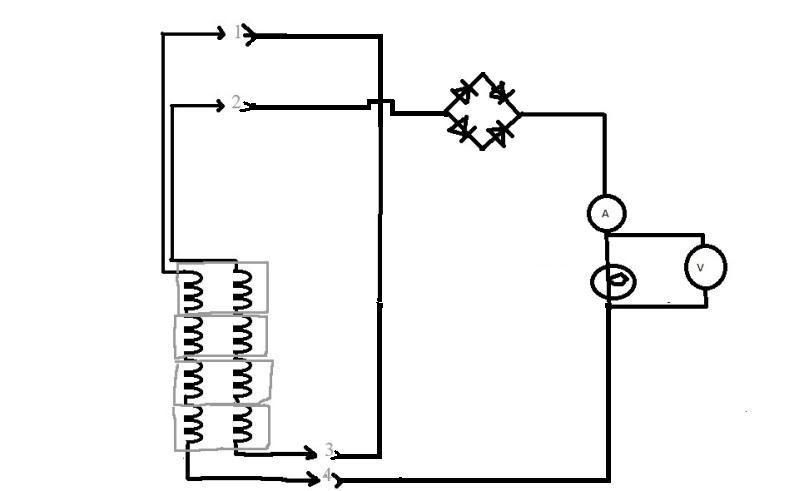
Halfwave series 'really' reversed, 3ohm, 3450rpm, Didn't try testing it again at 1ohm either
This was Bruce's request;
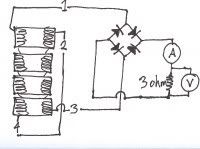

Halfwave, series, 1 ohm, 3450rpm, 3.7a, 17.4vac, 3.9vdc
Didn't bother photobucketing the pics of these...It's wearing me down and I'm starting to slack off, lol.
Halfwave, 'one side', 1 ohm, 3450rpm, 3.4a, 13.6vac, 3.5vdc
Halfwave, 'the other side', 1 ohm, 3450rpm, 3.7a, 13.4vac, 3.6vdc
This is another one I must have missed due to it (the drawing anyway) being added-after-the-fact, back a way's.
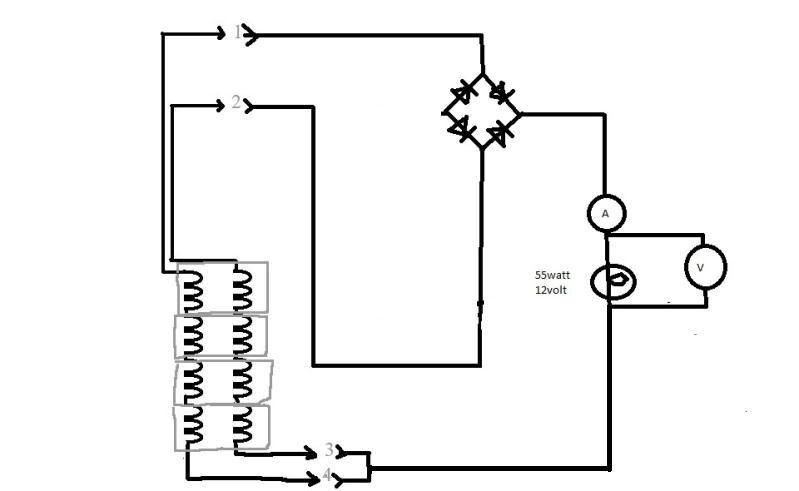
'stock' parallel, 1ohm, 3450, 3.8a 5.1vac, 3.8vdc (I was wondering about the unused rec. ground so I jumpered it to the alt. side of the load and got 2.2a, 3.4vac, 2.3vdc, no clue if this means anything at all...)
<EDIT>The ac reading on this is erroneous as the meter is hooked in wrong, there is correct data for this setup on page 21.
Am I now up to date with the test requests?
Bob, I saw somewhere your response about the cutoff pics. I am running firefox 4 but didn't have the problem previous to that so that's not it. I notice that your drawing pics are a bit smaller than mine, somehow I can see 1024 wide and you are getting only 748, I can only conclude it's due to the monitor size difference. I love my new 24" led backlit screen that was only $179, sell a carburetor or something and get one and you'll wonder why you waited so long....
<EDIT>I fired up my old system with the tube monitor, even with resolution set at 1280x1024 my 1024x768 pics are cutoff, (so more than 1280 horizontal monitor pixels are required). It's to do with the format of this forum and that the right margin takes up too much space in the window (particularly for the little information contained there).
Looks like I may have to go back through everything and shrink all my pics...
...I'm meeting a friend of mine to tutor one of my daughters for her Physics exams. He actually is a Physics professor. Any questions???
Oh yes, have him read the whole thread and offer an opinion...:lol.:
I have a friend that is quite a preeminent Physicist who does a lot of work with high voltage but I wouldn't even have a clue as to what to ask him about this thread.
Bill
Last edited by wcorey on Fri Aug 19, 2011 4:52 am, edited 4 times in total.
Return to “Ducati Singles Main Discussions (& How to Join)”
Who is online
Users browsing this forum: No registered users and 71 guests